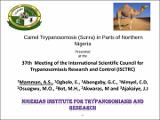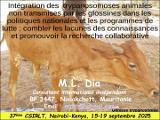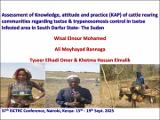Animal Health: Recent submissions
Now showing items 1-20 of 192
-
Identification et diversité des tabanidés et stomoxes vecteurs mécaniques des trypanosomes dans deux localités de la vina (CAMEROUN)
(2025)Cette étude vise à améliorer les connaissances sur les tabanidés et stomoxes dans le but d’envisager la lutte anti vectorielle efficace contre ces derniers afin d’accroitre la production animale et laitière -
Significance of non-tsetse transmitted animal trypanosomiasis/surra and their management
(2025)Non tsetse transmitted trypanosomiasis is significantly impacted livestock health, productivity, and livelihood thus should be given equal emphasis. Stomoxys species complex, similar to tsetse flies, feed on diverse wild ... -
Camel Trypanosomosis (Surra) in Parts of Northern Nigeria
(2025)Camel Trypanosomosis (Surra) is mainly caused by Protozoan parasite called Trypanosoma evansi. It is a neglected tropical disease affecting livestock of which camels & horses re mostly infected. It is prevalent in all ... -
African Common Position for Sustainable, Resilient and Nature-positive Livestock Food Systems
(2025)The "Common African Position" is a coordinated approach developed by the African Union (AU) to represent Africa's collective interests and views on international matters on livestock. It is a platform for Africa to speak ... -
Trypanosoma evansi en Algérie : épidémiologie, typage moléculaire et rôle des hôtes domestiques
(2025)●Trypanosoma evansi (Surra): parasite majeur du dromadaire ● Transmission par insectes hématophages (Tabanidae, Stomoxys) ● Impact : mortalité, baisse de production, pertes économiques -
Assessment of Knowledge, Attitude and Practices (KAP) of Cattle rearing communities regarding tsetse and trypanosomiasis control in tsetse infected area in South Darfur State , The Sudan
(2025)Livestock rearing is one of the major economic activities in most of Darfur region including South Darfur and a source of livelihood to rural communities. and makes a significant contribution to food security and income ... -
Geometric morphometric analysis of tsetse flies in Kiéré (Côte d’Ivoire): towards a targeted strategy to combat animal trypanosomiasis
(2025)Côte d'Ivoire eliminated human African trypanosomiasis as a public health problem in December 2020 and is currently aiming to halt transmission by 2030 -
Smelling Out Solutions: Advancing targeted smell-based strategies for Trypanosomiasis control
(2025)Development and use of baits targeting more of trypanosome infected G. pallidipes and application of integrated vector control and treatment approaches is a promising strategy in managing AAT -
Capitalizing on Climate Change-Environment- Socioeconomics Nexus for sustainable and scalable T&T interventions
(2025)La trypanosomose animale africaine (TAA), transmise principalement par les mouches tsé-tsé, est bien plus qu’un problème vétérinaire : c’est unfrein majeur au développement rural, à la sécurité alimentaire et à la gestion ... -
Translating available technologies and innovations for scalable and sustainable tsetse field actions: The Case of Niayes Senegal
(2025)As part of the management of AT, a National Programme for the Control of Tsetse and Trypanosomiasis in Senegal (PNLTTS) was set up by Decree No. 3139 of 22 May 2006 -
A metabarcoding approach to examine the ecology of the tsetse fly in Forecariah, a focus of Human African Trypanosomiasis in Guinea
(2025)Using metabarcoding, to elucidate the transmission route of Tbgambiense in a complex co-epidemiological context, with a view to adapt vector control strategies and reach sustainable elimination of transmission of HAT in Guinea



















